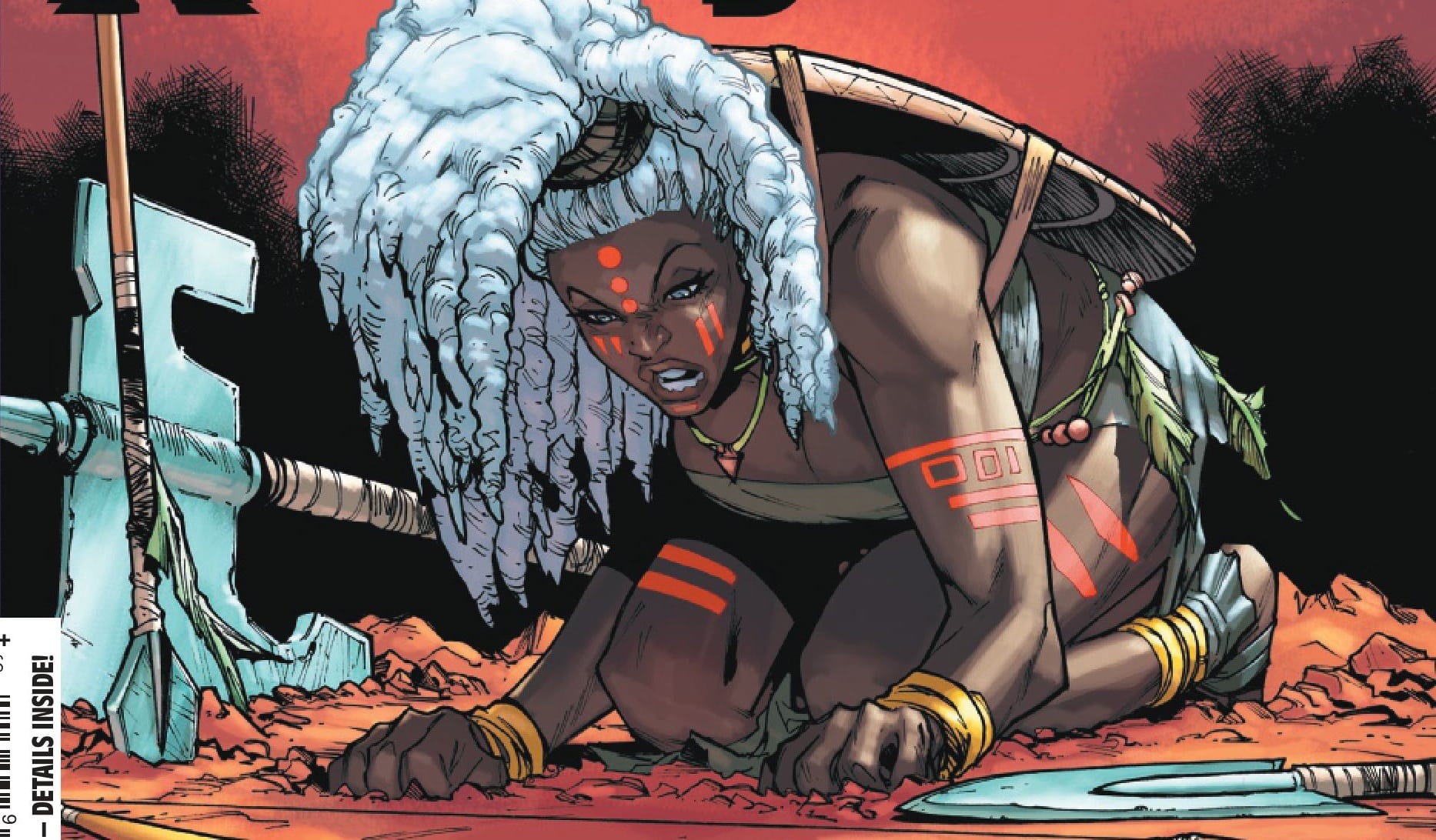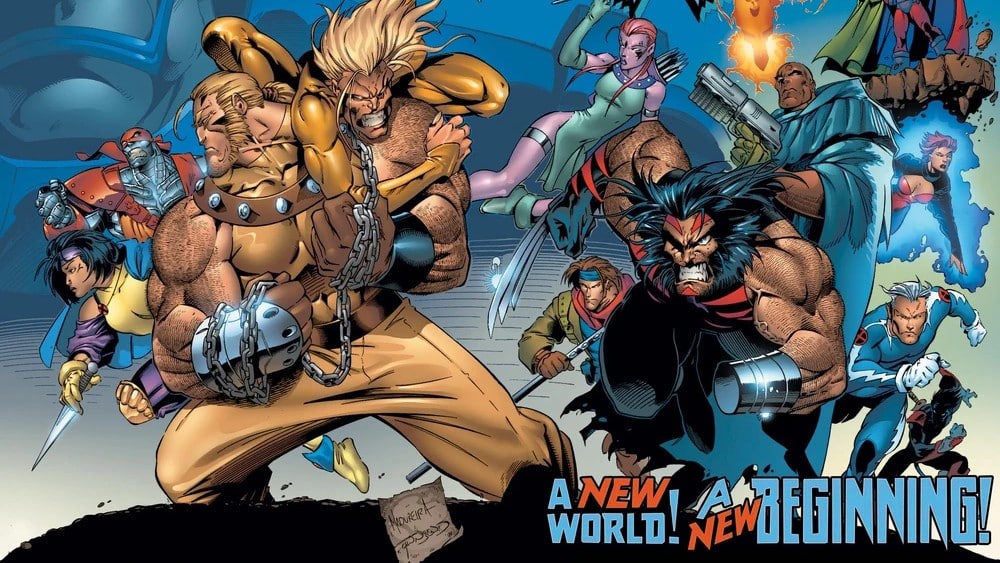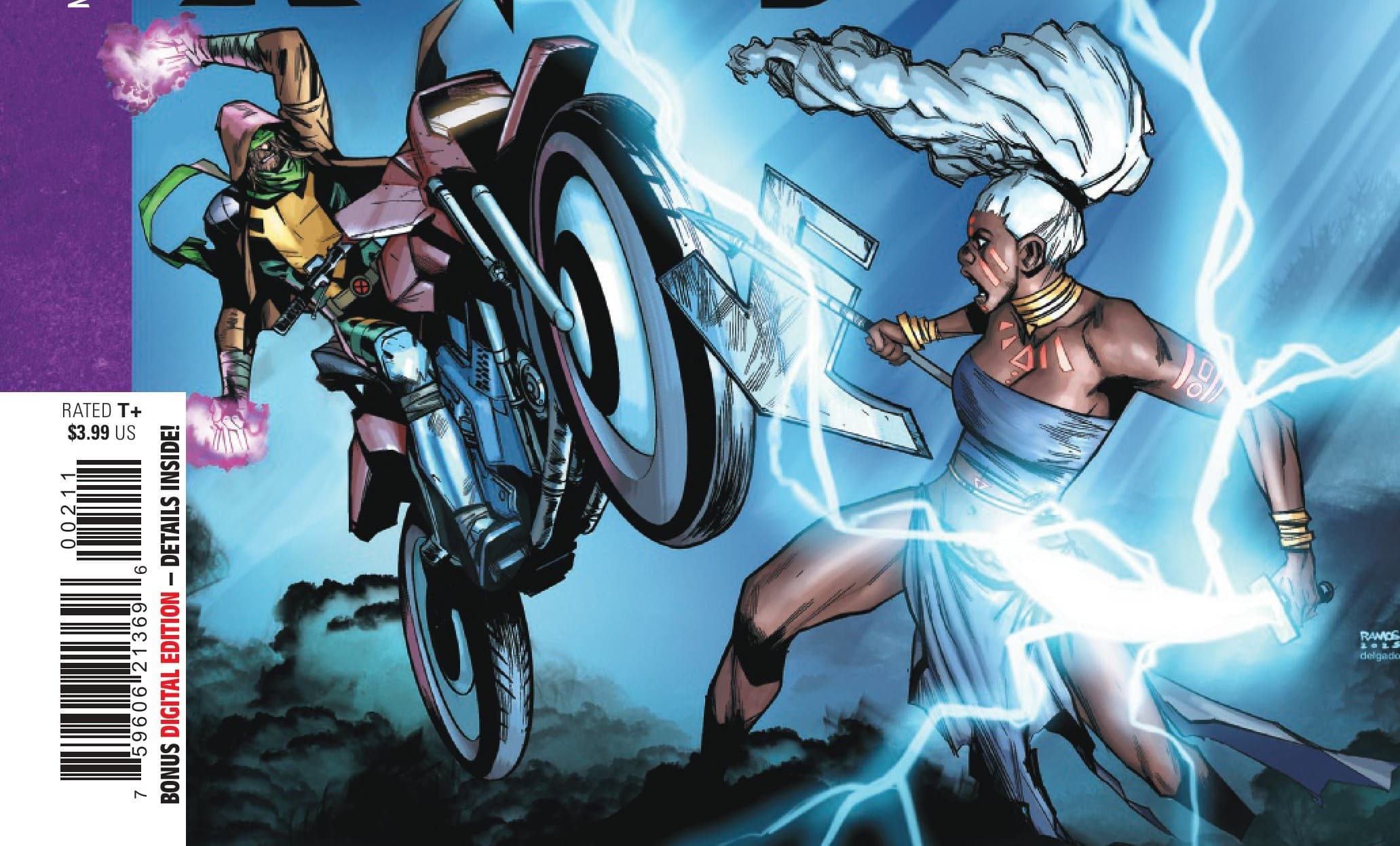Ten years from now, Mars has been destroyed, and Storm wants revenge. To get it, the New Brotherhood will battle their way through hell to seek the greatest secret of the Sinister Age. But are they fighting to save the world, or end it? And who the hell is Ironfire? Storm and the Brotherhood of Mutants #1 is written by Al Ewing, drawn by Paco Medina, colored by Jay David Ramos and lettered by Ariana Maher.
If I asked someone what, say, Lord of the Rings was about — someone who somehow, someway, hasn’t read the books or watched the movies or fell down a Wikipedia hole — they’d probably say, “It’s about rings, duh.” And of course they’d be right … kinda. The precious is pivotal, obviously, but a tale only about a search for a ring wouldn’t have such lasting cultural resonance.
You could say the same about Game of Thrones, or Paradise Lost, or any number of memorable works whose titles refer to an object but whose relevance is tethered to the journey of people to find fulfillment and peace.
So it is with Storm and the Brotherhood. Yes, the never-been-resurrected queen of weather headlines the book; but, at least in this first issue, a Sins of Sinister-branded continuation of X-Men Red, Storm is merely the object: The more interesting parts of the story circumvent her. This doesn’t necessarily make the book bad or the story uninteresting or unfulfilling, but it does raise some frustratingly familiar questions about her autonomy.
The story eschews ambitious narrative conceits for a linear journey: The Arakko mutants have been targeted for destruction by the Sinister-possessed Krakoan council. The Arakkii once again find themselves defending themselves against the inevitable, only to succumb: Arakko (Mars) is destroyed, along with most of her people. Only a few remain: some scattered across the cosmos, six lying in wait among the asteroid belt ruins, aching for revenge.
A revenge that it seems (seems!) may finally be afoot: We see Storm talking to Destiny, ostensibly about the aforementioned events, but more likely as a means of Storm venting (and us, the audience, getting caught up on what’s been going down).

Of course, things aren’t always as they seem, as Destiny is really Mystique, who’s arrived to give our marooned mutants a message: All of the pain they’ve endured can be undone if they find and destroy (kill?) the copies of Moira that Sinister’s hidden.
Storm, with a bit of noticeable hesitation, assembles the survivors for the mission, notably including Loolo (who we first saw being saved by a NASA scientist during Uranos’ siege) and a Xilo-bonded Cable.
The team arrives at Sinister’s subterranean Muir Island hideout and is immediately attacked (by flesh-eating bones, no less!). Yet, as always, Storm finds a way, burrowing underground to find the Moiras encapsulated by a living force field. Wiz Kid manages to teleport the whole force field away … only to reveal himself as not Wiz Kid, but Mystique. She stabs Storm in the back (how apt), leaving new character Ironfire to mourn.
Thus we end with the Arakkii even worse off, and our criminal coupling sharing intel with the spade-headed Sinister in a sphere, teasing what i suspect is the ultimate goal of all involved, literally and figuratively:
Dominion.
What I’ve appreciated about Ewing’s writing — his means of framing fights as emotional battles, his ability to aptly juggle simultaneous scenes seamlessly, his way of giving characters unique, identifiable voices — seems absent here. This is very much an exposition-filled jaunt, with characters telling you everything you need to know as directly and explicitly as possible. Every line from Storm serves the plot and nothing more: She tells us where we are, what we need to know, who’s going where. Absent from her dialogue is any agency or autonomy. I don’t know how she feels about what’s transpired; I don’t know her plans for herself or her future, her hopes or dreams, her sadness at betrayal or the pain of losing those she was entrusted to protect.

Nor, sadly, do any other characters get any development here, save for Ironfire, the metal-bleeding mutant who serves as our emotional anchor, and the spry, secretive coupling of Destiny and Mystique. Ironfire is the only person who shows an emotion other than angst, and only then at the very end of the comic; Mystique and Destiny use deceit and trickery as calling cards, manipulating our expectations time and time again, both physically and narratively. That we can’t get a read on their intentions, that we can’t trust anything we see or hear from them, piques interest: The only thing we can trust is their love for each other, a love they would see to the end of everything, even if it means the end of everything.
Romantic? Maybe. Sadistic? Absolutely.
And of that Spade Sinister: Clearly no Sinister can be trusted, but I do wonder if maybe one of them may have mutated a moral core. I wouldn’t bet on it, not at all, but I do wonder if any of the playing cards has anything more than tricks up their sleeves.
There were some interesting teasers: Mention of a “Genesis War” likely hints at the post-SoS return of Apocalypse and family — a teaser made all the more interesting by the inclusion of Death, son of Apocalypse and Genesis, among those fighting for Arakko. There are also more questions: Where are the Shi’ar or, notably, the Intergalactic Empire of Wakanda, an empire Storm had a hand in saving? Where is Cable’s hidden ship, with years’ worth of history and weapons?
And yet, I left the experience feeling underwhelmed. The concept of the comic was intriguing, but the execution felt rote, by the book, flaccid. Compared not just to Ewing’s previous work, but to say X of Swords or Judgment Day, Brotherhood feels less emotional, less connected, less concerned with the character development and more concerned with moving the plot.
You might think that my critiques mean the comic is bad; I assure you it is not. I’m well aware this is the first issue, and a lot of scene setting needs to take place. This is a clear, engaging read that illustrates the ramifications of letting Sinister go wild. Still, this reads well below the standards Ewing’s set for himself: very much like a synopsis of an interesting idea than an actually interesting story.
The Krakoan era is still missing a comic that consistently gives Storm a full voice: where she is the full subject of the story, where her hopes and dreams and passions and disappointments and anger are palpable. Much like “Giant Sized X-Men: Storm,” her visage is used for inspiration for others as opposed to autonomy. Action moves around her, yet she has little agency or engagement in determining where and how that action moves. Compare her rather stoic pronouncements here to the first issue of Red, where she struggles with self-doubt only to emerge strengthened, resolved to destroy thrones. I was hoping for that kind of development here; it feels like my hope, like that of the Arakkii, may betray me yet again.
So while I’m very much invested in what comes next, my expectations and anticipation of what comes next have certainly, sadly, been lowered.
A proud New Orleanian living in the District of Columbia, Jude Jones is a professional thinker, amateur photographer, burgeoning runner and lover of Black culture, love and life. Magneto and Cyclops (and Killmonger) were right. Learn more about Jude at SaintJudeJones.com.






